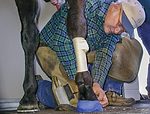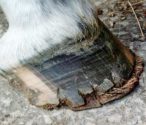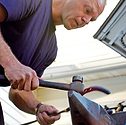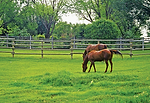Advertise Follow Us
Articles by Pat Tearney
Rehabilitating horses doesn’t have to be financial disaster
Read More
Old Horses, New Problems
Aging horses become more susceptible to arthritis, laminitis and other issues that present hoof-care challenges
Read More
Metallurgy: How Much Do You Need to Know?
While not necessary to shoe horses, a working knowledge of how steel is made and reacts to heat and pressure can make a good career great
Read More
Matching the Shoe to the Job
Experienced farriers say the choice should be based on a number of factors, many of which have nothing to do with the shoe itself
Read More
Farriers Sweat The Small Stuff To Keep Performance Horses Competing
Sore feet, abscesses occur regardless of discipline and require quick and effective hoof care
Read More
Guarding Against Springtime Laminitis
Educating clients and being vigilant for early warning signs can head off this potentially deadly malady
Read More
Warning Signs Of Shoe Wear
Paying attention to unusual patterns or changes in this area can help you head off potentially serious soreness issues
Read More














